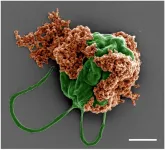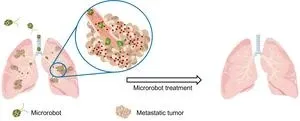(Press-News.org) Engineers at the University of California San Diego have developed microscopic robots, known as microrobots, capable of swimming through the lungs to deliver cancer-fighting medication directly to metastatic tumors. This approach has shown promise in mice, where it inhibited the growth and spread of tumors that had metastasized to the lungs, thereby boosting survival rates compared to control treatments.
The findings are detailed in a paper published on June 12 in Science Advances.
The microrobots are an ingenious combination of biology and nanotechnology. They are a joint effort between the labs of Joseph Wang and Liangfang Zhang, both professors in the Aiiso Yufeng Li Family Department of Chemical and Nano Engineering at the UC San Diego Jacobs School of Engineering.
To create the microrobots, researchers chemically attached drug-filled nanoparticles to the surface of green algae cells. The algae, which provide the microrobots with their movement, enable the nanoparticles to efficiently swim around in the lungs and deliver their therapeutic payload to tumors.
The nanoparticles are made of tiny biodegradable polymer spheres, which are loaded with the chemotherapeutic drug doxorubicin and coated with red blood cell membranes. This coating serves a critical function: it protects the nanoparticles from the immune system, allowing them to stay in the lungs long enough to exert their anti-tumor effects. “It acts as a camouflage,” said study co-first author Zhengxing Li, who is a nanoengineering Ph.D. student in both Wang and Zhang’s research groups. “This coating makes the nanoparticle look like a red blood cell from the body, so it will not trigger an immune response.”
This formulation of nanoparticle-carrying algae is safe, the researchers noted. The materials used to make the nanoparticles are biocompatible while the green algae employed, Chlamydomonas reinhardtii, are recognized as safe for use by the U.S. Food and Drug Administration.
This study builds on prior work by Wang and Zhang’s teams using similar microrobots to treat deadly pneumonia in mice. “Those were the first microrobots to be safely tested in the lungs of live animals,” said Wang.
In previous work, the microrobots fought the spread of pneumonia-causing bacteria using a different drug and cell membrane combination for the nanoparticles. By tweaking these components, the team has now tailored the microrobots to fight the spread of cancer cells in the lungs. “We demonstrate that this is a platform technology that can actively and efficiently deliver therapeutics throughout the entire lung tissue to combat different types of deadly diseases in the lungs,” said Zhang.
In the current study, mice with melanoma that had metastasized to the lungs were treated with the microrobots, which were administered to the lungs through a small tube inserted into the windpipe. Treated mice experienced a median survival time of 37 days, an improvement over the 27-day median survival time observed in untreated mice, as well as mice that received either the drug alone or drug-filled nanoparticles without algae.
“The active swimming motion of the microrobots significantly improved distribution of the drug to the deep lung tissue, while prolonging retention time,” said Li. “This enhanced distribution and prolonged retention time allowed us to reduce the required drug dosage, potentially reducing side effects while maintaining high survival efficacy.”
Moving forward, the team is working on advancing this microrobot treatment to trials in larger animals, with the ultimate goal of human clinical trials.
Paper: “Biohybrid microrobots locally and actively deliver drug-loaded nanoparticles to inhibit the progression of lung metastasis.” Co-authors of the study include Fangyu Zhang*, Zhongyuan Guo*, Zhengxing Li*, Hao Luan, Yiyan Yu, Audrey T. Zhu, Shichao Ding, Weiwei Gao and Ronnie H. Fang.
*These authors contributed equally to this work.
This work was supported by the Defense Threat Reduction Agency Joint Science and Technology Office for Chemical and Biological Defense (HDTRA1-21-1-0010) and the National Institutes of Health (R21AI175904).
END
Swimming microrobots deliver cancer-fighting drugs to metastatic lung tumors in mice
2024-06-12
ELSE PRESS RELEASES FROM THIS DATE:
Ambivalence + polarized views can promote political violence
2024-06-12
COLUMBUS, Ohio – Feeling ambivalent about a political issue might seem to be a recipe for indecision and even inaction.
But a new study suggests, surprisingly, that ambivalence can actually lead some people –especially those with polarized views – to be more supportive of extreme actions, such as violence.
The reason? Researchers found that ambivalence creates discomfort in those with extreme views by making them feel weak or insecure about their beliefs – and that can lead them to compensate for that weakness by supporting extreme actions to signal strength.
“When people have ...
Unleashing the power of metamaterials to improve MRI imaging
2024-06-12
In recent years, the field of metamaterials has experienced substantial growth, revealing exciting potential, especially in advancing magnetic resonance imaging (MRI) technology. Three new studies led by Dr. Xin Zhang, a BU College of Engineering Distinguished Professor and a professor at the BU Photonics Center, highlight the promising opportunities within this field. These studies, in collaboration with Dr. Stephan Anderson, a BU Chobanian & Avedisian School of Medicine professor of radiology, published in Advanced Science, Advanced Materials, and Science Advances, showcase innovative approaches to enhance the MRI experience for all patients. ...
USC EdTech Accelerator collaborates with Intel
2024-06-12
USC Rossier Education Technology Accelerator (USC EdTech Accelerator) announced a unique collaboration with Intel Corporation focused on supporting the use of technology for learning with a particular emphasis on supporting marginalized communities and AI.
The Partnership
The USC EdTech collaboration with Intel will provide free educational and technical assistance to learning-focused start-ups to increase the likelihood that they design viable, efficacious and scalable AI-enhanced solutions for learners. “We believe ...
What is the neural mechanism behind helping someone at your own cost?
2024-06-12
Using a unique setup, researchers from the Social Brain Lab at the Netherlands Institute for Neuroscience have researched the neural mechanism behind a universal dilemma: deciding whether to help someone else even when it involves a personal sacrifice.
We often have opportunities to give up something we care about to help others. What brain mechanisms help us make those decisions, and why do some people help more than others?
Over the years, philosophers and scientists have suggested that the extent to which a person empathizes with the distress of others influences their willingness to help.
To explore this hypothesis experimentally, Kalliopi ...
Can we withdraw treatment in post-menopausal osteoporosis?
2024-06-12
Osteoporosis is characterised by low bone mineral density and bone fragility.5 During menopause, falling oestrogen levels impair normal bone turnover, with an average reduction in bone mineral density of 10%.5 This is compounded by the age-related bone loss that occurs in both men and women. With an ageing population, post-menopausal osteoporosis represents a growing health problem.
These new data are from a case-control cohort study of over 128,000 women included in the French national claim database. The main aim was to estimate the incidence of long-term discontinuation of bisphosphonates – ...
Vexas: towards molecular and phenotypic characterization
2024-06-12
VEXAS is characterised by predominantly rheumatic and haematologic systemic involvement, and caused by somatic mutation in UBA1 – a gene encoding ubiquitin-activating enzyme 1,1,2 which is necessary for a post-translation modification that affects protein functions ranging from degradation to subcellular localisation and kinase activation.3 The syndrome was first described in 2020, but diagnosis can be challenging as the symptoms overlap with many other inflammatory conditions.1 Hot on the heels of this recent discovery, research is underway to better understand pathogenesis, clinical features, and potential treatment options.1
To support this, ...
Location, location, location – does it matter in psoriatic arthritis?
2024-06-12
Arthritis affects various joints differently, despite systemic inflammatory cues.2 In people with rheumatoid arthritis, transcriptomic variances identified in synovial fibroblasts from various joint sites have been shown to translate into joint-specific phenotypes with distinct characteristics and responsiveness to cytokines.2,3 These findings suggest that different joints may potentially respond variably to specific immunosuppressive treatments. To expand on this, Ciurea and colleagues set out to investigate whether joints at different anatomical locations in people with PsA might respond differently to treatment with a tumour necrosis ...
Stopping the march
2024-06-12
The estimated prevalence of psoriatic arthritis (PsA) in people with psoriasis ranges widely –between 6% and 42% – but in most cases, skin symptoms precede PsA, thus making skin psoriasis a model for pre-PsA.2 Assuming that there are shared pathways in the pathogenesis, it is possible that stringent treatment of moderate-to-severe psoriasis could reduce progression to clinically overt PsA.3,4 Biologic treatments are effective at controlling psoriasis, but there are no conclusive data that these treatments help prevent people from developing PsA. Several risk factors for transition have previously been identified by a EULAR taskforce.5 ...
Predicting response in treatment-naïve RA
2024-06-12
The synovial tissue inflammation seen in RA shows high degree of heterogeneity – which may be a factor in people’s variable response to treatments. We also know that distinct synovial tissue macrophage subsets regulate inflammation and remission in rheumatoid arthritis.1 The potential of high-throughput analyses has been shown, and these technologies can help dissect disease heterogeneity and identify novel biomarkers that could be used in prognosis.2
To explore this further, 373 treatment-naïve RA patients were enrolled and given an ultrasound-guided synovial tissue biopsy. The synovitis degree and synovial pathotype was then determined for ...
Testing the systemic score for Still’s disease
2024-06-12
A multi-centre, observational, prospective study was designed to evaluate the clinical usefulness of the systemic score in predicting life-threatening evolution – defined as the development of macrophage activation syndrome (MAS) and/or mortality. The intention was also to derive a more aggressive clinical patient subset. To achieve this, Ruscitti and colleagues collected data from 597 patients taking part in the GIRRCS (Gruppo Italiano Di Ricerca in Reumatologia Clinica e Sperimentale) AOSD-study ...



